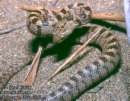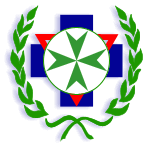Class: Amphibia; Discoglosus pictus
 The
Painted Frog is the only amphibian species present on the Maltese
Islands. Folkloristically, it was in the past given to sick children in
the form of a soup. An antidiuretic substance - Enteramine - has been
isolated from the skin of this species, but this is unlikely to have
any medical consequences with simple handling of specimens. The best
precaution is to ensure that hands are well washed after handing any
specimens. The Discoglossus pictus
is a protected species in the Maltese Islands and should not be taken
out of
its habitat.
The
Painted Frog is the only amphibian species present on the Maltese
Islands. Folkloristically, it was in the past given to sick children in
the form of a soup. An antidiuretic substance - Enteramine - has been
isolated from the skin of this species, but this is unlikely to have
any medical consequences with simple handling of specimens. The best
precaution is to ensure that hands are well washed after handing any
specimens. The Discoglossus pictus
is a protected species in the Maltese Islands and should not be taken
out of
its habitat.
Class: Reptilia
 There are only four species of snakes represented on the
Maltese Islands. These all belong to the Family Colubridae, all member of which are
non-poisonous to man. Some colubrids, exemplified by the local Cat
Snake Telescopus
falax have poison fangs at the back of the mouth. Though
technically
a venomous species, these snakes are harmless to humans. Snakes are
usually
fairly timid creatures and they only bite humans in defense, when
touched,
trodden upon or cornered. When they strike, they do so with amazing
speed,
usually at the legs or hands of their attacker. In the majority of
instances,
snakes prefer to avoid human contact. All the resident reptiles are
protected species in the Maltese Islands and should not be taken out of
their habitat.
There are only four species of snakes represented on the
Maltese Islands. These all belong to the Family Colubridae, all member of which are
non-poisonous to man. Some colubrids, exemplified by the local Cat
Snake Telescopus
falax have poison fangs at the back of the mouth. Though
technically
a venomous species, these snakes are harmless to humans. Snakes are
usually
fairly timid creatures and they only bite humans in defense, when
touched,
trodden upon or cornered. When they strike, they do so with amazing
speed,
usually at the legs or hands of their attacker. In the majority of
instances,
snakes prefer to avoid human contact. All the resident reptiles are
protected species in the Maltese Islands and should not be taken out of
their habitat.
- The
management of snakebite in Malta is in the large majority of cases very
simple and aimed at reassuring the victim [and his/her relatives] that
the snake was harmless and no harm will come to the victim.
- Local
treatment as for small puncture wounds should be instituted, keeping in
mind that the mouths of snakes can be infested with bacteria. A booster
tetanus toxoid
injection can be given as a precaution.
The tortoise species
[and also many other reptilian species] may serve as Salmonella carriers; and care
should be taken in food-handling after handling these animals. The
previous folklore belief that the Maltese geckoes brought on leprosy
and other
skin disease has no scientific basis and was based on the warty
appearance
of these animal's skins.
Class: Avis
Certain species of bird can deliver a nasty bite when handled. This
should
be managed in the routine management of animal bites [see below].
Certain
species of birds can be carriers of Chlamydia
psittaci which can cause
an infectious atypical form of pneumonia. Psittacosis is found
prinsipally
in the psittacine birds
comprising parrots, parakeets and love-birds; less
often in poultry, pigeons and canaries (in whom the disease is often
called
ornithosis); and occasionally in the snowy egret and some sea-birds
(e.g.
herring gulls, petrels, and fulmars). Human infection usually occurs by
inhaling
dust from feathers or excreta of infected birds; it may also be
transmitted
to man by a bite from an infected bird. Ornithologists and bird
breeders
are at particular risk.
Class: Mammalia
There are a number
of mammalian species which may cause bite injuries to humans. These may
include the rodents [e.g. Rattus
rattus and Rattus norvegicus]
and the weasel [Mustella nivalis].
However most mammalian bites refer to the domesticated species - the
dog and cat. These bite injuries may be quite extensive
requiring surgical treatment.
Treatment of bites:
- The
treatment of mammalian bites requires the usual treatment of wounds
with careful cleansing with antiseptics and debridment. All wounds
sustained from contact with teeth are potentially serious, owing to the
risks of infection. [Human bites are however much more dangerous than
dog bites because of the unusual virulence of the organisms concerned].
Bites of all description should be treated with great respect.
Exploration and debridement should be particularly thorough, and should
be carried out, if necessary, under general anesthesia. The number of
stitches should
be reduced to a minimum. Appropriate antibiotic therapy should be
prescribed and anti-tetanus toxoid given.







 The
Painted Frog is the only amphibian species present on the Maltese
Islands. Folkloristically, it was in the past given to sick children in
the form of a soup. An antidiuretic substance - Enteramine - has been
isolated from the skin of this species, but this is unlikely to have
any medical consequences with simple handling of specimens. The best
precaution is to ensure that hands are well washed after handing any
specimens. The
The
Painted Frog is the only amphibian species present on the Maltese
Islands. Folkloristically, it was in the past given to sick children in
the form of a soup. An antidiuretic substance - Enteramine - has been
isolated from the skin of this species, but this is unlikely to have
any medical consequences with simple handling of specimens. The best
precaution is to ensure that hands are well washed after handing any
specimens. The  There are only four species of snakes represented on the
Maltese Islands. These all belong to the Family
There are only four species of snakes represented on the
Maltese Islands. These all belong to the Family 